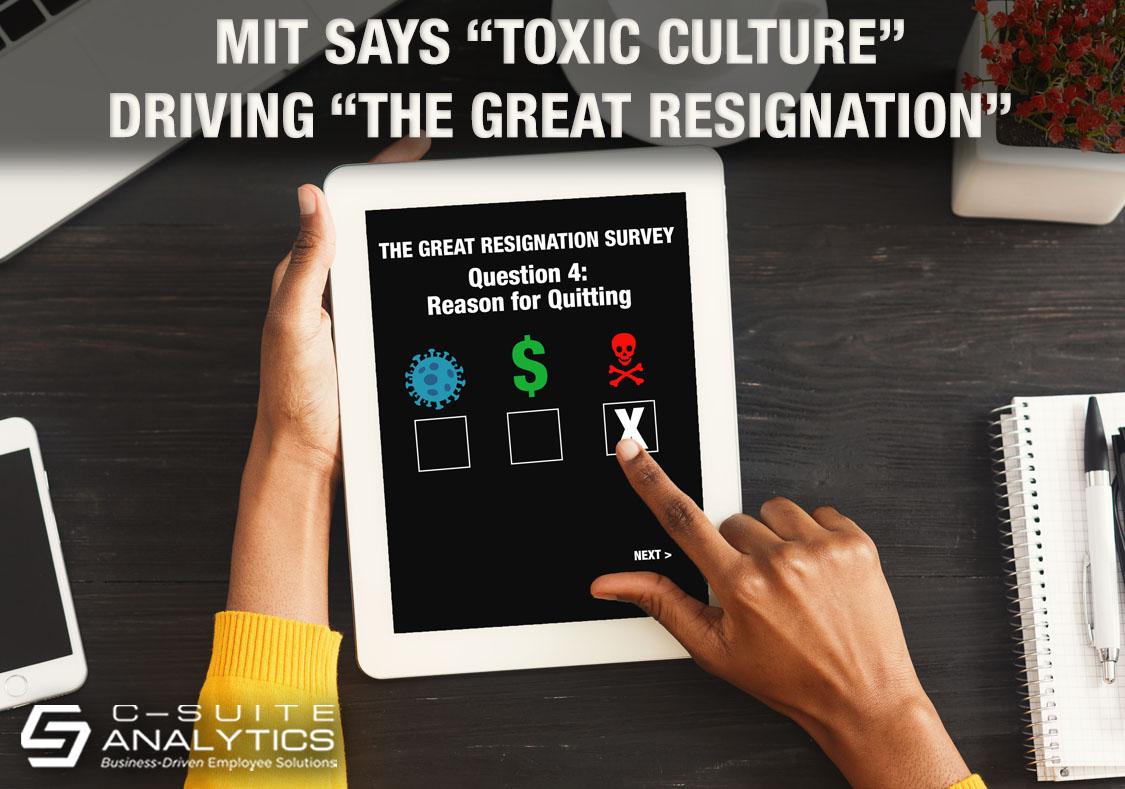Most hiring tools answer whether candidates can and will do the job, but not if they’ll stay. Learn how realistic job previews and motivational-fit interviews can improve retention from day one.
MIT says “Toxic Culture” driving “The Great Resignation”

Last week I offered 10 data-driven reasons why “The Great Resignation” is the new normal. Those reasons were from a societal perspective, a combination of the ways Americans are thinking and demographics related to aging, birthrates, and the like. Now along comes MIT researchers who present a different perspective, one that offers reasons from inside organizations that are driving workers away.
The study’s scope is impressive as the researchers analyzed 34 million online profiles to identify reasons why U.S. workers left jobs for any reason between April and September of 2021. They also looked at one million-plus Glassdoor reviews. Their findings include some interesting quirks, for example while apparel retailers lost employees at three times the rate of medical device makers and other white-collar workers, the authors also state that “The Great Resignation” is affecting blue-collar and white-collar workforce sectors with equal force. They also found that while companies with healthy culture reputations had less turnover…think Southwest Airlines, Enterprise Rent-A-Car…more innovative companies like SpaceX and Netflix had higher turnover.
The meat of the study regards why employees are quitting their jobs in droves, and here are their top-five reasons. Compensation finished 16th as a leave reason so you won’t see it on this list…even though pay is most companies’ first level knee-jerk reaction to retaining employees. The top leave reasons during “The Great Resignation” are:
- Toxic corporate culture
- Job insecurity and reorganization
- High levels of innovation
- Failure to recognize employee performance
- Poor response to COVID-19
At first glance, “toxic corporate culture” looks like an aggregation of many aspects of work, but thankfully the researchers break it down into three distinct categories: failure to promote diversity, equity, and inclusion; workers feeling disrespected; and unethical behavior. And they tell us “toxic corporate culture” is…wait for it…10 times more important than compensation in predicting turnover.
Examples offered for reasons two through five are what you might expect, though the authors express surprise that innovation leads to turnover and they also clarify that recognition means “You did a good job” in my words versus raising an employee’s pay.
Now the article gets more interesting. The authors present four short-term actions to boost retention, presented in their order of impact relative to increasing pay which remember is 16th on their heavily-researched list:
- Lateral work opportunities
- Remote work assignments
- Company-sponsored social events
- Offering predictable schedules
After re-reading the article, it’s hard to tell if these proposed fixes are also based on extensive research or if the authors identified them as their best logical solutions to the stated causes. But for starters, it’s difficult to envision how their top solution, lateral work opportunities, will improve their three-item definition of toxic corporate culture which is failure to promote diversity, equity, and inclusion/workers feeling disrespected/unethical behavior. Nor to be blunt, do the dots connect between the remaining top leave reasons of job insecurity/innovation/lack of recognition/COVID response and the remaining solutions that include remote work assignments/social events/predictable schedules.
The authors left me at hello when they made the switch from causes for quits to solutions. And I can’t help but wonder how many of their causes are driven by first-line supervisors considering phrases such as “workers feeling disrespected” and “failure to recognize employee performance”. And how, I wonder, would more company social events solve any of their top-five leave reasons?
I’ve reached out to the authors but have not yet heard back. My purpose is to share long-held data that the top reason employees quit jobs or disengage from them is how much they trust their immediate supervisors…and nothing in their top-five reasons tells me otherwise. I would then suggest they apply our Finnegan’s Arrow solution of convert turnover to dollars/establish retention goals/train leaders to conduct Stay Interviews/train leaders also to forecast each employee’s length of service/and then hold leaders accountable to goals and forecasts.
The study noted here is good because it is current, covering a period during “The Great Resignation” and happening during our continuing COVID struggles, too. And this invites the question as to whether Finnegan’s Arrow is effective in these times versus 2019 and prior. And the answer is “yes”, as detailed in our annual report blog from two weeks ago.
What strategies for retaining employees work best? Schedule a free Retention Strategy Session with me at DFinnegan@C-SuiteAnalytics.com for a free consultation. We will share with you what has worked for companies just like yours to cut turnover by 30% and more even during “The Great Resignation”.
https://sloanreview.mit.edu/article/toxic-culture-is-driving-the-great-resignation/



